Side DishItalianBreadRosemary
Homemade focaccia is simply the BEST! It's easy to make, but be sure to give yourself the afternoon. You'll be rewarded with a rich, rosemary-scented bread that feeds a crowd. Serve as an appetizer or as a side with soup, roasts, or braises.
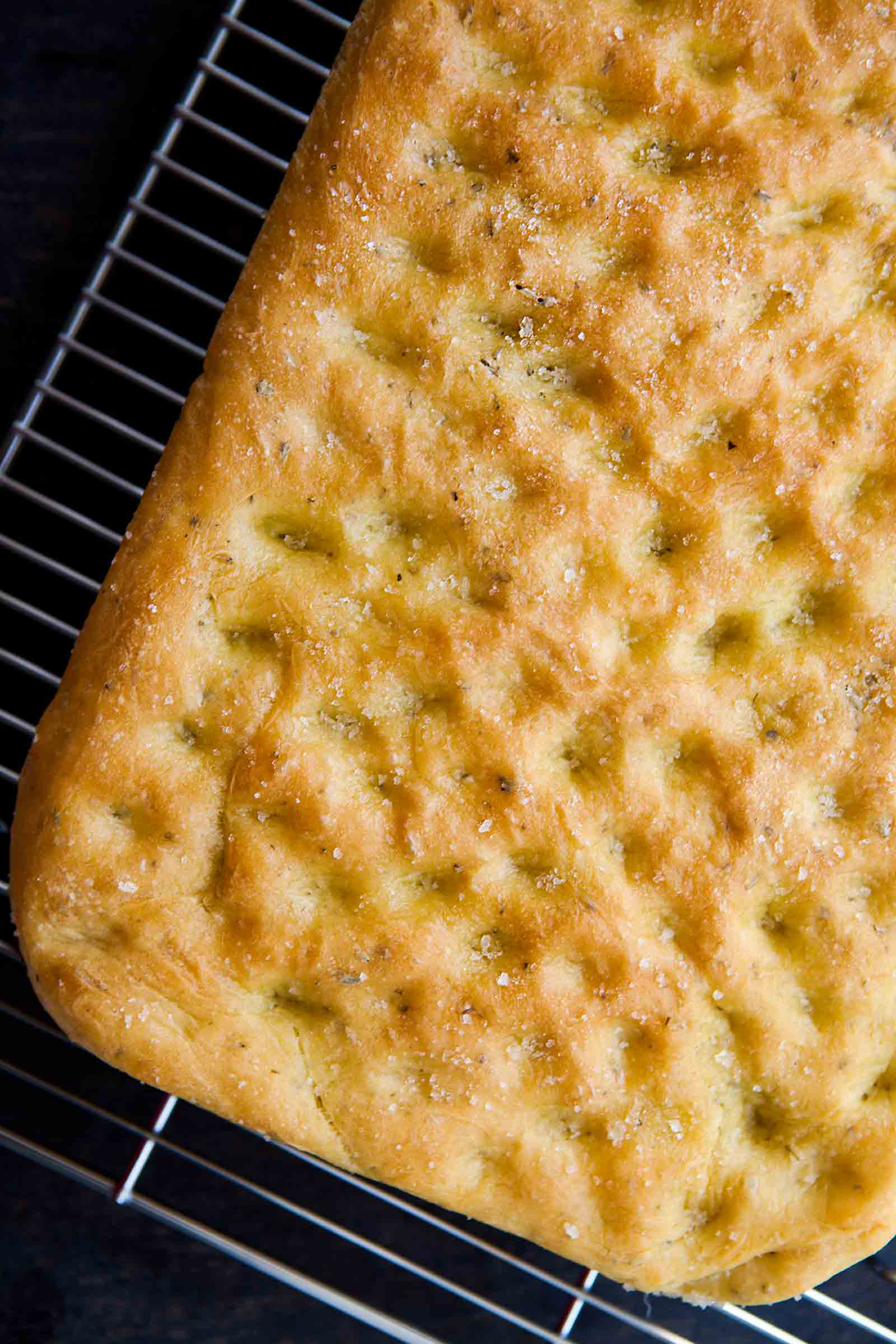
Have you ever made your own focaccia bread?
I’m not much of a yeast-bread baker, but I’ve been curious about this Italian bread for years. We use it often for sandwiches; it’s filled with the flavor of olive oil, soft and sturdy at the same time, and dimpled all over.
Well, if you too have been curious about making focaccia, I’m here to strongly suggest that you try it! Hank taught me how to make it and believe me, this bread is seriously good.

The Best Focaccia Takes Time
Yes, it takes the good part of the day to make (but most of that time goes to just waiting for the dough to rise, thrice). And if you’re lazy like me, or with embarrassingly out-of-shape biceps (also like me), you can easily mix and knead the whole thing in an electric mixer.
So it’s easy. No excuses, kimosabe.
Make Focaccia Your Way
This recipe makes enough dough for 2 good-sized loaves. Or you can do what we’ve done, which is take 2/3 of the dough and bake it in a 9×15-inch baking pan, and the remaining third of the dough free-form on a baking sheet.
You can make it all in free-form loaves that look like puffy pizzas, or shape them into casseroles or cake pans – there are no absolutes on the shape of this bread.
This Focaccia Will Feed a Crowd
This rosemary focaccia bread is so good that even though the recipe makes enough for a platoon, I’m pretty sure I could eat the whole thing.
I literally had to force myself to give much of the last batch away, to parents, neighbors, anyone within reach with an appetite. Purely selfish motives that was, to save myself from an embarrassing chat with the scale.
Storing and Freezing Focaccia
Like most breads, this focaccia freezes well. You can also slice several day old focaccia bread and toast it, serving it with butter and/or honey.
Try Your Hand at These Homemade Breads!
- Garlic Knots
- Whole Wheat Bread
- Homemade Rye Bread
- Irish Soda Bread
- Homemade Indian Naan
Updated March 30, 2020 : We spiffed up this post to make it sparkle. No changes to the original recipe. Follow me on Pinterest  Save It
Save It  Saved Print
Saved Print
Rosemary Focaccia Recipe
- Prep time: 30 minutes
- Cook time: 20 minutes
- Total Rising time: 4 hours
- Yield: Makes a large loaf and a small loaf of 1 1/2 to 2 inches thick.
The bread takes on the flavor of the olive oil so use a good quality extra virgin olive oil.
Recipe adapted from The Italian Baker by Carol Field.
Ingredients
- 1 package (2 1/4 teaspoons) dry yeast
- 1/3 cup warm water, about 100 degrees
- 2 1/4 cups tepid water
- 2 tablespoons good quality extra virgin olive oil, plus more for the pan and to paint on top of the bread
- 3 cups bread flour
- 4 1/2 cups all-purpose flour
- 1 tablespoon salt, plus coarse salt (fleur de sel if you have it, otherwise Kosher salt) for sprinkling over the top
- 2-3 tablespoons finely chopped fresh rosemary (can use sage or other herbs such as thyme or oregano, but whatever herb you use, do use fresh herbs, do not use dried)
Method
1 Proof the yeast: Stir the yeast into the 1/3 cup of slightly warm-to-the-touch water and let it rest for 10 minutes.
2 Add olive oil to water, then add yeast: In a large bowl, pour in 2 1/4 cups of tepid water and 2 tablespoons olive oil. After the yeast has rested for 10 minutes and has begun to froth, pour it into the water-oil mixture.
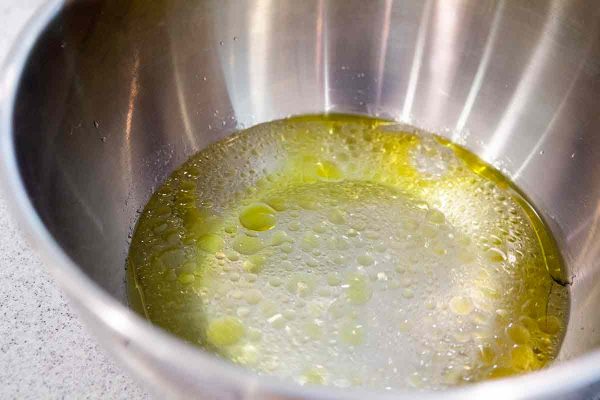
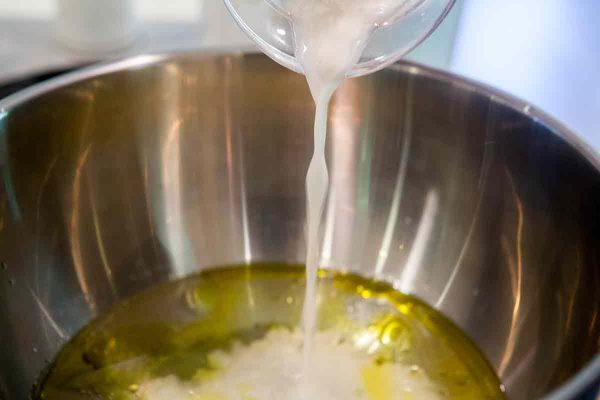
3 Add flour and rosemary: Whisk in 2 cups of flour (either the bread flour or the all purpose, at this stage it doesn't matter which) and the tablespoon of salt. Add the rosemary.
Cup by cup, whisk in the rest of the flour (both the bread flour and all-purpose). As the mixture goes from a batter to a thick dough, you'll want to switch from a whisk to a wooden spoon.
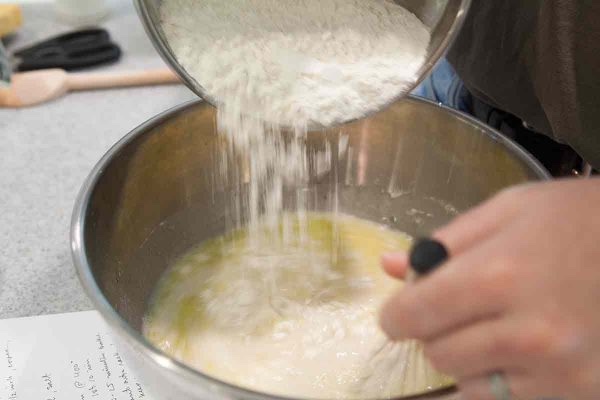
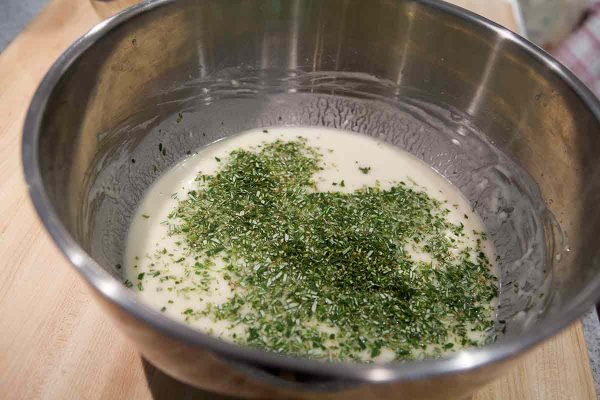
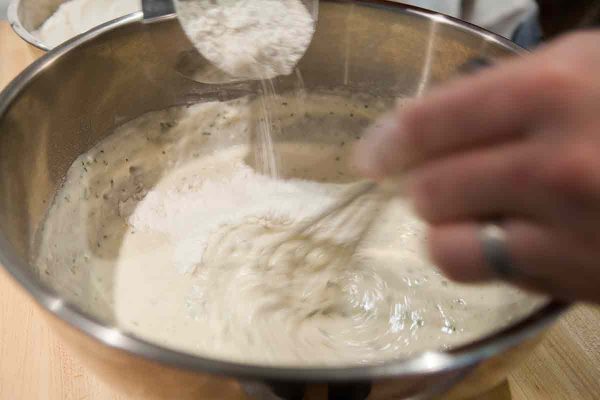
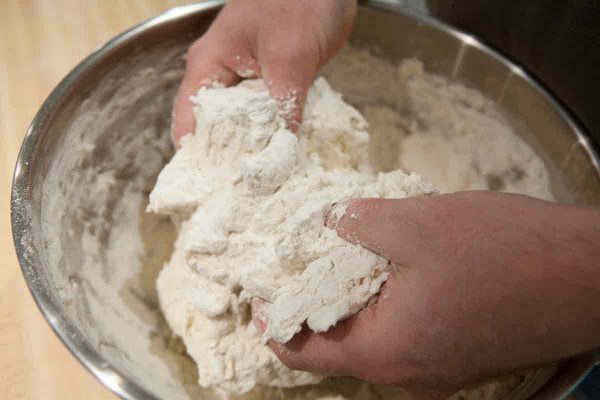
4 Knead the dough: By the time you get to adding the last cup of flour, you will be able to work the dough with your hands. Begin to knead it in the bowl – try to incorporate all the flour stuck to the sides and bottom of the bowl as you begin kneading.
Once the bowl is pretty clean, turn the dough out onto a board and knead it well for 8 minutes. You might need some extra flour if the dough is sticky.
Note that a KitchenAid mixer (or some other brand of upright electric mixer) works well for the mixing and kneading of the bread dough. About the time you add the last cup of flour you'll want to switch from the standard mixer attachment to the dough hook attachment.
Just knead the dough using the dough hook on low speed for 8 minutes. If after a few minutes the dough is still a little sticky, add a little sprinkling of flour to it.
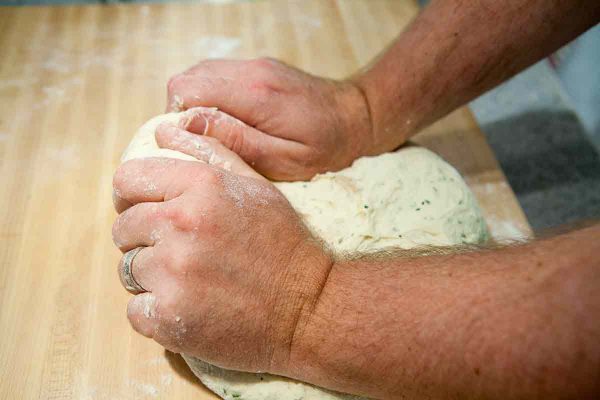
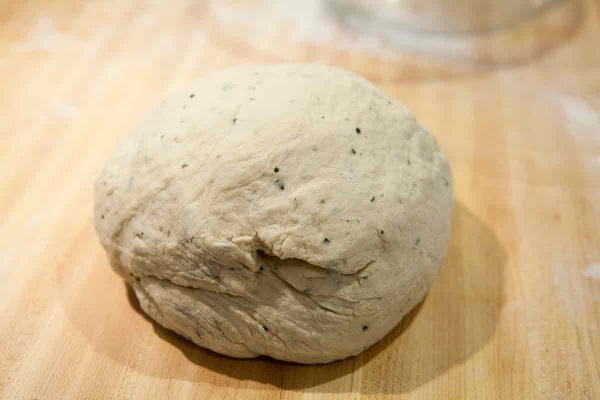
5 First rise: In a large clean bowl, pour in about a tablespoon of oil and put the dough on top of it. Spread the oil all over the dough.
Cover the bowl with plastic wrap and set aside to rise (in a relatively warm spot or at room temp) for an hour and a half. It should just about double in size.
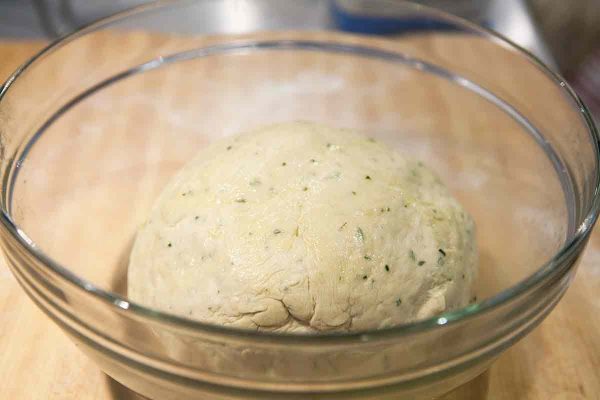
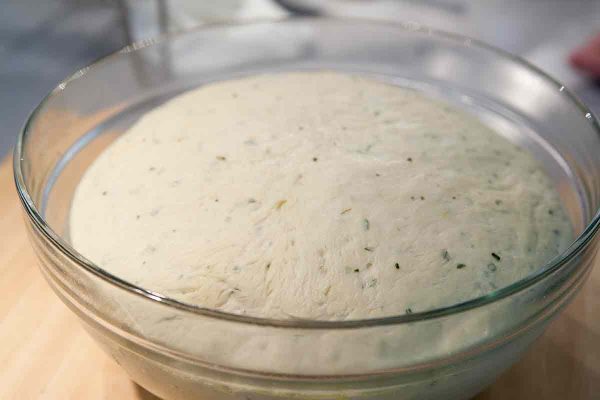
6 Spread dough in baking pan: Spread a little olive oil in your baking pan or baking sheet (will make it easier to remove the bread). Place the dough in your baking pans or form it into free-form rounds on a baking sheet.
This recipe will make two nice-sized loaves or one big one and a little one. Cover the breads and set aside for another 30 minutes.
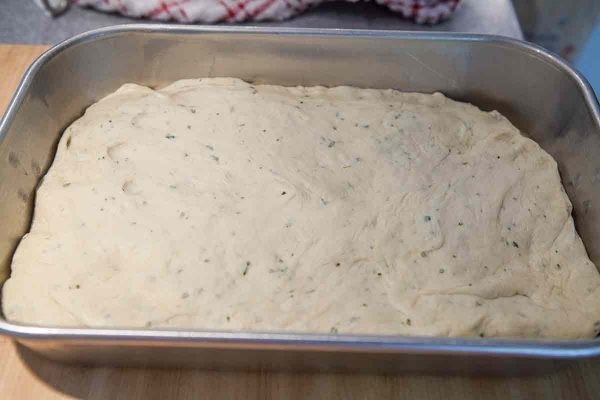
7 Dimple the bread: Dimple the breads with your thumb. Push in to about the end of your thumbnail, roughly 1/2-inch.

8 Second rise: Cover the dough again and leave it to rise for its final rise, about 2 hours.
9 Preheat oven: With 30 minutes to go before the rise finishes, preheat your oven to 400°F. If you have a pizza stone put it in.
10 Brush with olive oil, sprinkle with salt: Once the dough has done its final rise, gently paint the top with olive oil — as much as you want.
Then sprinkle the coarse salt on top from about a foot over the bread; this lets the salt spread out better on its way down and helps reduce clumps of salt.
11 Bake: Put the bread in the oven. If you are doing free-form breads, put it right on the pizza stone. Bake at 400°F for a total of 20-25 minutes.
If you have a water spritzer bottle, spritz a little water in the oven right before you put the bread in to create steam, and then a couple of times while the bread is baking.
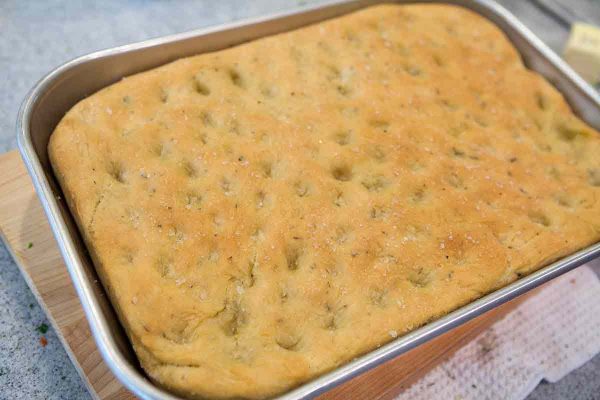
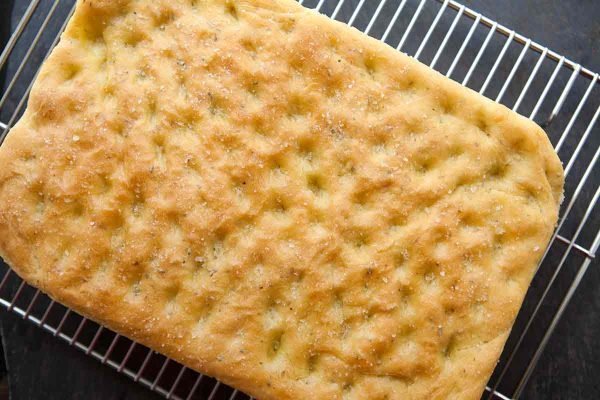
12 Cool and serve: When the bread comes out of the oven, turn it out onto a rack within 3-5 minutes; this way you'll keep the bottom of the bread crispy. Let cool on a rack for 10 minutes before eating.
Hello! All photos and content are copyright protected. Please do not use our photos without prior written permission. Thank you!
This post may contain links to Amazon or other partners; your purchases via these links can benefit Simply Recipes. Read more about our affiliate linking policy.
 Elise Bauer
Elise Bauer
Elise Bauer is the founder of Simply Recipes. Elise launched Simply Recipes in 2003 as a way to keep track of her family's recipes, and along the way grew it into one of the most popular cooking websites in the world. Elise is dedicated to helping home cooks be successful in the kitchen. Elise is a graduate of Stanford University, and lives in Sacramento, California.
More from Elise






